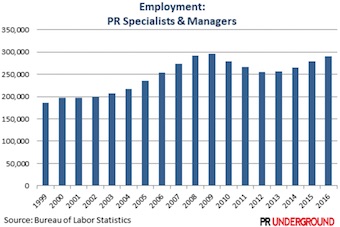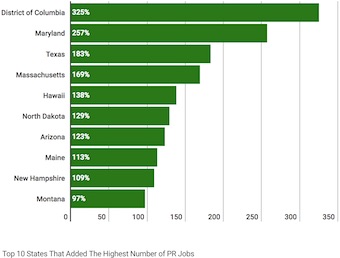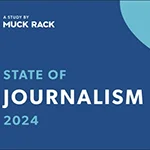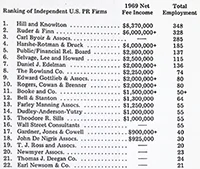While employment figures in the PR industry have risen for four consecutive years, they still lag behind the peak levels reached in 2009, says a new report from PR Underground.
According to the study, based on data compiled by the Bureau of Labor Statistics, the industry added 11,620 jobs in 2016, hitting a total of 209,910. Despite that hike, the number of jobs still lagged behind 2009’s total by about 5,000.
 |
 |
The growth trend did not float all boats equally, however. When it comes to pay, the gap between managers and non-managerial employees continued to widen. From 2008 to 2016, managers saw 10.98 percent growth in real income, with an average 2016 salary of $123,360. For non-managerial employees, a combination of small pay raises (up to an average of $66,540 for 2016) and increasing inflation led to a microscopic .09 percent growth in real income during the same period. Things are even worse for entry-level workers, who have seen their real income drop by 4.42 percent.
Location proved to be a major factor in both number of PR jobs and in the salaries that those jobs pay, the study says. Washington, D.C. has seen a PR employment boom, with 325 percent more jobs in 2016 than in 1999. States that have seen big employment jumps include Maryland (up 257 percent from 1999), Texas (up 183 percent), Massachusetts (up 169 percent) and Hawaii (up 138 percent). States that have seen declines for that period include Wisconsin (down 41 percent), Connecticut (down 25 percent) and West Virginia (down 18 percent).
The nation’s capital also ranked near the top in salaries paid to both managerial and non-managerial employees, with only the Bay Area averaging higher pay for non-managers and the New York metro area topping D.C. for managerial salaries. However, when the cost of living is factored in, Providence, RI sits at the top of heap for non-managers, while managers do the best in the Durham-Chapel Hill area of North Carolina.
Another takeaway from the study is that trade associations and other business groups have shifted a significant part of their lobbying budgets from traditional lobbyists to PR firms. In 1999, the report says, there were twice as many lobbyists as PR professionals in D.C. By 2016, that ratio was inverted.


 Brand has a powerful effect on a company’s valuation, but the level of brand understanding in the investment community leaves a lot to be desired, according to a new study from Brodeur Partners, Interbrand and NewtonX.
Brand has a powerful effect on a company’s valuation, but the level of brand understanding in the investment community leaves a lot to be desired, according to a new study from Brodeur Partners, Interbrand and NewtonX. AI may still be viewed with a wary eye by most media pros, but its use is growing, according to a new study from Muck Rack.
AI may still be viewed with a wary eye by most media pros, but its use is growing, according to a new study from Muck Rack. A new study from Walker Sands says that some marketers have been putting the cart before the horse when it comes to the relationship between marketing channels and business outcomes.
A new study from Walker Sands says that some marketers have been putting the cart before the horse when it comes to the relationship between marketing channels and business outcomes. Thought leadership can make made B2B brands more "powerful and attractive to buyers," according to Edelman report.
Thought leadership can make made B2B brands more "powerful and attractive to buyers," according to Edelman report. The deadline for O'Dwyer's 2024 rankings of PR firms, a benchmark study of the growth of the industry annually since 1970, is Mon., Mar. 11, 2024.
The deadline for O'Dwyer's 2024 rankings of PR firms, a benchmark study of the growth of the industry annually since 1970, is Mon., Mar. 11, 2024.


 Have a comment? Send it to
Have a comment? Send it to 
No comments have been submitted for this story yet.